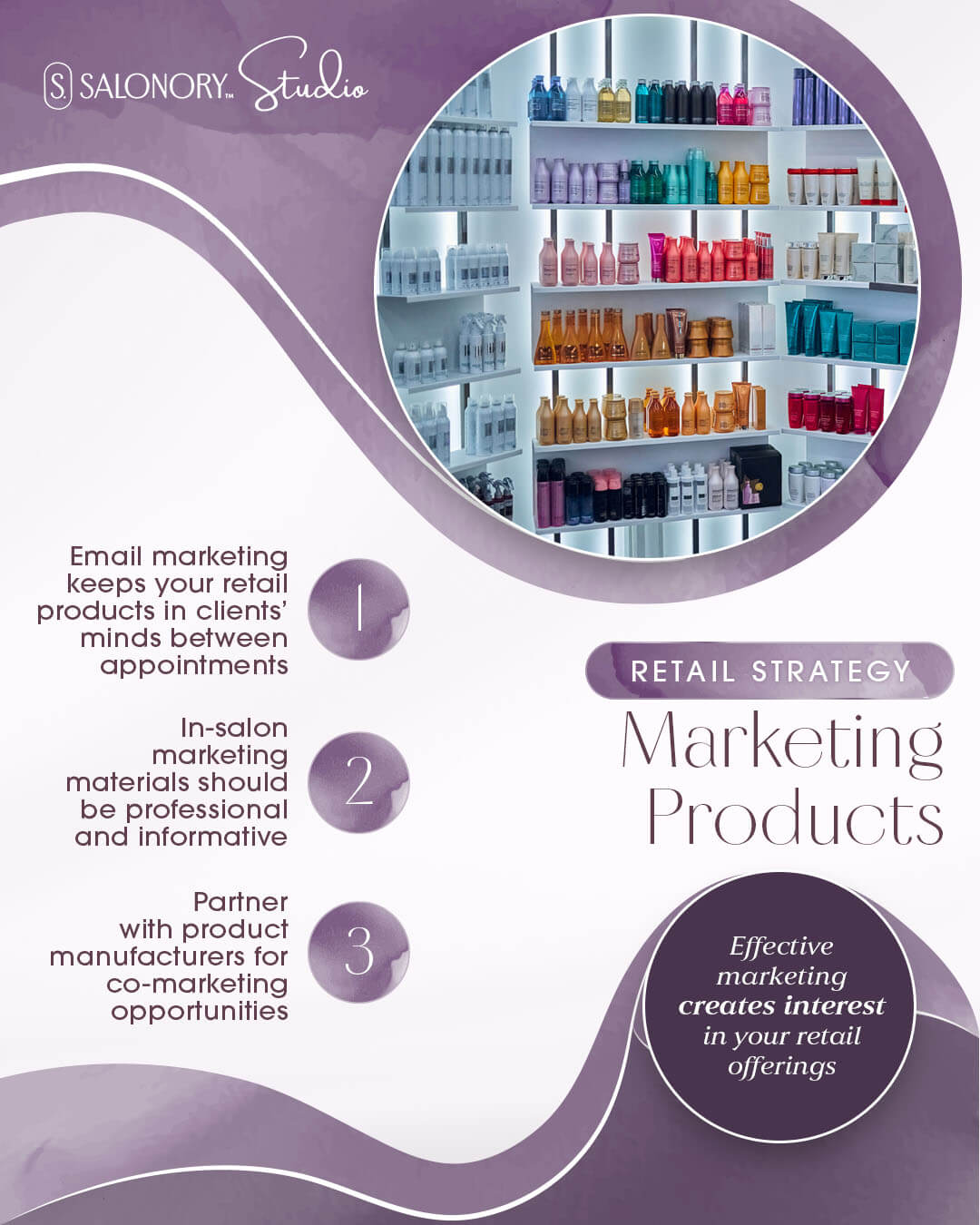Running a successful salon takes more than top-notch styling skills. You also need a robust retail strategy that transforms your business from a service-only establishment into a comprehensive beauty destination.
The beauty industry has seen remarkable growth in retail sales, and as a salon owner, you should get your share of this lucrative market. Your clients already rely on your hair expertise, making them more likely to trust your recommendations. This trust forms the foundation of successful salon retail, allowing you to build stronger relationships while boosting your bottom line. Read on to explore salon owner tips to elevate your retail game!
Understanding Your Retail Opportunity
Many salon owners underestimate the money-making potential of their business’s retail area. While services generate the most revenue, retail products have higher profit margins and create opportunities for passive income. When clients purchase products from your salon, their profitability extends beyond their appointment.
On average, about eight percent of a salon’s revenue comes from retail sales. However, retail sales can account for up to 20 percent of a high-profit salon’s revenue. The exact percentage varies depending on location, clientele and product selection, but retail offers substantial revenue opportunities in all markets. More importantly, retail sales provide consistent income that helps balance the seasonal fluctuations common in the beauty industry.
A solid retail strategy begins with an understanding of your clients’ needs and preferences. For example, young professionals might prioritize time-saving styling products, while mature clients often seek anti-aging hair treatments. Analyzing your client base helps you curate a product mix that meets their needs.
Product Selection and Inventory Management

Your product selection sets the stage for retail success and should reflect your salon’s brand identity while addressing your clients’ most common hair concerns. Stick to professional hair styling products that deliver superior results compared to drugstore alternatives.
Start with a focused product line featuring brands that align with your salon’s quality standards and price position rather than overwhelming your limited retail space. Consider factors like product performance, packaging appeal, brand reputation and profit margins when making your selections.
Inventory management requires a careful balance between maintaining sufficient stock and not tying too much capital up in products. Popular products, such as dry shampoo, heat protectants and styling creams, typically have high turnover rates, while specialized treatments move more slowly. Pay close attention to your sales data to identify fast-moving items and seasonal trends.
Build relationships with product suppliers to negotiate favorable terms and ensure reliable delivery. Many distributors also offer promotional programs, training opportunities and marketing support that can boost your retail performance. Take advantage of these resources to make the most of your retail investment.
Staff Training and Product Knowledge
Your team’s product knowledge directly impacts retail sales. Clients rely on your staff’s expertise when choosing hair care products. Ensure every team member understands the benefits, usage instructions and target clients for every product you carry.
Plan regular training sessions to keep your staff up to date on new products and reinforce effective selling techniques. When training, do role-playing exercises to help stylists practice making product recommendations to clients. When your team understands and believes in the products they sell, their enthusiasm is contagious and translates to higher conversion rates.

Create product knowledge sheets that outline key selling points for each item. Include information about ingredients, benefits, application methods and which clients would benefit most from each product. These reference materials help newer team members learn about products and build confidence while ensuring your entire staff is on the same page.
Offer commissions or bonuses to incentivize retail sales. When your stylists benefit from retail sales, their motivation to recommend products and improve their selling skills increases.
Creating an Effective Retail Environment
The appearance of retail displays has a significant impact on purchasing behavior. Your products should be easily accessible, well-organized and arranged in an aesthetically pleasing manner. Strategically placing products near your reception area, styling stations and checkout counter maximizes exposure and encourages impulse purchases.
Well-lit displays make products appear more appealing, so consider investing in retail lighting that highlights your products without creating a glare or harsh shadows. Your goal is to create a space where clients are comfortable browsing and examining products.
Demonstrations are a great way to encourage sales, especially for new additions to your product lineup. Set up an area where clients can touch, smell and sample products. Hands-on experiences increase clients’ purchasing confidence and reduce the likelihood of returns.
Organize products by category, hair type or brand. Add clear signage to help clients navigate your retail selection, and make sure all price tags are visible and appear professional.
Pricing Strategies That Work
Pricing your retail products can be challenging because you need to consider both profitability and the amount clients are willing to spend. Most salons apply a markup of 50-100 percent over wholesale costs, depending on the product type and local market conditions. Pay attention to local competitor pricing to ensure your rates are competitive but maintain healthy margins.
Offer premium products alongside more affordable options to cater to a range of budgets. With this approach, you can make sales even when clients cannot afford top-tier products. It also shows your clients that you care about their needs, regardless of their budget.
Bundle pricing encourages larger purchases while increasing average transaction values. Put together sets that combine complementary products at reduced prices. For example, you could pair a clarifying shampoo with a deep conditioning treatment or offer a complete styling kit with multiple products.
Seasonal promotions drive retail sales during slower periods. Plan promotional campaigns around holidays, back-to-school season and special events. Consider offering limited-time promotions to build a sense of urgency and encourage clients to make purchases they might otherwise postpone.
Building Client Relationships Through Retail
Retail sales can help you build stronger client relationships that extend beyond the styling chair. When you recommend products that improve their hair’s condition or make styling easier, you prove your commitment to their overall satisfaction. It also shows that you care about their hair’s long-term health.
Exceeding expectations and providing value beyond the appointment are crucial components of learning how to build clientele as a hairstylist. When clients purchase products, follow up with them to answer any questions they have and ensure satisfaction. This personal touch builds loyalty and encourages repeat purchases. Consider creating a client database that tracks product purchases, and use the information to make personalized recommendations during future appointments.
Marketing Your Retail Products
Effective marketing creates interest in your retail offerings, and your social media platforms are excellent places to showcase products. Share before-and-after photos featuring products you used, styling tutorials and client testimonials about their favorite purchases.
Email marketing keeps your retail products in clients’ minds between appointments. Send newsletters featuring new arrivals, seasonal recommendations and exclusive subscriber offers. Include educational content about proper product usage and hair care tips that incorporate products sold at your salon.

In-salon marketing materials should be professional and informative. Create things like product brochures, benefit sheets and usage guides that clients can take home. These materials serve as reminders of your recommendations, making it easier for clients to recall specific products they wish to purchase.
Partner with product manufacturers for co-marketing opportunities. Many brands provide promotional materials, samples and advertising support. Take advantage of any available resources to supplement your marketing efforts without spending a lot of extra money.
Measuring Success and Adjusting Your Strategy
Track your salon’s retail performance through metrics that provide insights into the effectiveness of your marketing strategy. Closely monitor sales volume, profit margins, inventory turnover and average transaction values. These numbers help you identify trends and make data-driven decisions about future product selection and pricing.
Analyze which products generate the highest profits and which items linger on shelves. Consider discontinuing slow-moving and low-profit items to free up capital for more profitable products.
Client feedback also provides valuable insights into your retail strategy’s strengths and weaknesses. Regularly ask clients about their experiences with products they’ve purchased, and use their responses to refine product recommendations and identify opportunities for improvement.
Advanced Retail Strategies
When you want to take your efforts to the next level, consider more advanced retail strategies. For example, you could launch a subscription service to create a recurring revenue stream while delivering convenience to your clients. Offer monthly or quarterly product deliveries featuring their favorite items or curated selections based on their hair type and preferences. This model builds predictable income while strengthening client relationships.
Investing in exclusive products or private label items is another way to differentiate your salon from competitors. Collaborate with manufacturers to develop custom formulations and packaging that reflect your brand identity. Exclusive products command premium prices and give clients another reason to choose your salon over others.

Additionally, you can never go wrong with gift cards and retail packages. They make excellent gifts and introduce new clients to your salon. Consider offering gift sets that combine services with retail products to drive revenue and enhance the customer experience.
You can also increase sales by educating clients on proper hair care techniques and the benefits your products offer. Host workshops, create educational content and position everyone on your team as a hair care expert. Doing so builds trust and credibility while naturally leading to product recommendations.
Overcoming Common Challenges
Many salon owners struggle with staff members who are reluctant to sell products. The best way to overcome this common challenge is by emphasizing the service aspect of retail sales rather than focusing solely on revenue generation. When team members understand that product recommendations help clients maintain their hair’s health and appearance, they usually feel more comfortable making suggestions.
Inventory management challenges arise when salons carry too many products or fail to track sales data effectively. Implement systems that monitor stock levels, track sales patterns and alert you when you need to reorder. This systematic approach keeps you from running out of popular products while minimizing excess inventory.
Clients are often hesitant to pay premium prices for salon-quality products when drugstore brands are significantly less costly. Focus on benefits rather than features when making recommendations. Explain how professional products deliver better results and potentially save money because their more-concentrated formulas mean a little bit goes a long way.
Space limitations are a common struggle for salon owners, but they don’t have to limit retail success. Maximize your available space by strategically placing vertical displays in high-traffic areas. Rotating seasonal items also frees up space. For example, you could display UV protectants during the summer and deep conditioners in the winter. Consider creating a catalog system for products you don’t stock regularly but can order for interested clients.
Closing Thoughts

A solid retail strategy offers a significant opportunity to increase your salon’s revenue, strengthen client relationships and build a more sustainable business model. However, ensuring your success requires careful planning, consistent execution and continuous improvement based on performance data and feedback from your clients. With the right strategy and authentic approach, you can create value for both your clients and your business while establishing your salon as a complete beauty destination rather than just a place to get a haircut.
Start small with a moderate selection of products, and build gradually based on your results. Most importantly, always prioritize your clients’ needs and listen to their concerns when making product recommendations. With a client-focused perspective and a dedication to developing a solid retail strategy, retail success will naturally follow. Start planning today, and before you know it, you could see a significant increase in revenue through retail sales and enhanced customer loyalty.
Image Credits
IndiTheater/Shutterstock.com
SmLyubov/Shutterstock.com
anna spoka/Shutterstock.com
PeopleImages/Shutterstock.com
BearFotos/Shutterstock.com
4 PM production/Shutterstock.com
Monkey Business Images/Shutterstock.com
Tyler Olson/Shutterstock.com












Share Your Feedback